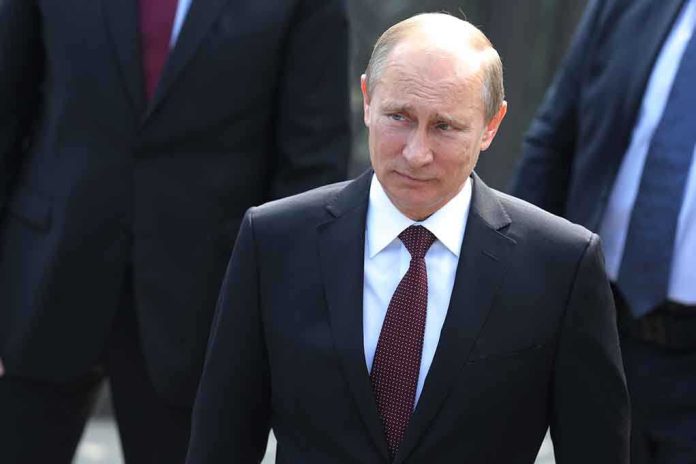
Russia’s claim of an “invincible” nuclear-powered missile test is less about engineering and more about rewriting the rules of twenty-first-century nuclear brinkmanship—leaving adversaries and onlookers to wonder: What does Russia gain by boasting of a weapon no one can independently verify?
Story Snapshot
- Putin announces a successful 15-hour, 14,000 km test flight of the Burevestnik nuclear-powered cruise missile
- Moscow hails the missile as “invincible” due to its unpredictable flight path and theoretical unlimited range
- No independent evidence or technical data has been shared, fueling Western skepticism
- Test timing amplifies pressure on Ukraine, NATO, and global nuclear stability
Putin’s “Invincible” Missile: A New Era of Uncertainty
On October 25, 2025, Vladimir Putin stood before his security chiefs and declared, “Now the decisive tests have been completed.” With that, Russia unveiled what it claims is a strategic game-changer: the Burevestnik cruise missile, allegedly capable of flying for 15 hours and covering 14,000 kilometers without refueling. Russian state media, rarely subtle, quickly branded it “invincible,” a word that—by design—ricochets through Western capitals with the force of an ICBM’s sonic boom.
Putin’s timing is no accident. With Russian troops still entrenched in Ukraine and tensions with NATO at a post-Cold War high, Moscow’s message could not be clearer: Russia is not only resisting Western pressure but escalating its technological brinkmanship. The Burevestnik, also known to NATO as SSC-X-9 Skyfall, isn’t just another missile—it’s a symbol of Russia’s intent to outmaneuver Western missile defenses, projecting power across continents and timelines.
Engineering Marvel or Imaginary Monster?
The missile’s claim to fame is its nuclear propulsion, allowing for near-unlimited range and an unpredictable flight path. This theoretically makes it impossible for current missile defense systems to intercept. For Russia’s domestic audience, it’s a rallying cry of national pride, proof that Western sanctions and isolation cannot halt Russian innovation. For Western analysts, however, it’s a cause for skepticism. The Burevestnik’s development history is littered with failed tests, accidents, and a notorious 2019 incident that reportedly killed several engineers during a previous trial. No independent verification or telemetry data has been released to support the latest success.
Technical experts point out that nuclear-powered missiles are complex, dangerous to operate, and pose environmental risks. Western intelligence agencies question not just the missile’s reliability but its very existence as a deployable weapon. Russian officials, meanwhile, remain tight-lipped, offering no evidence beyond official pronouncements and patriotic fanfare.
Strategic Messaging: Who’s the Real Audience?
Putin’s announcement serves multiple audiences. Domestically, it signals to Russians that their nation remains a technological superpower, undeterred by Western encirclement. Internationally, it sends a shot across NATO’s bow, warning that any attempt to check Russian ambitions could trigger responses far beyond conventional warfare. The Burevestnik’s theoretical ability to evade interception undermines years of Western investment in missile shields, potentially forcing a reassessment of nuclear deterrence and defense strategies.
The test’s timing—amid ongoing fighting in Ukraine and a concurrent series of Russian missile launches—underscores Russia’s intent to set the pace and terms of the new nuclear arms race. NATO and the US, for their part, have responded with caution, demanding transparency and verification. Yet, with Russia controlling the narrative and access, the world is left to parse meaning from statements and context, not hard data.
Implications: Arms Race, Anxiety, and Unanswered Questions
The Burevestnik’s public unveiling ratchets up anxiety in Ukraine and neighboring states, already on edge from the daily realities of war. Russian saber-rattling has long been a tool for domestic solidarity and international leverage, but this latest chapter introduces a new level of uncertainty. Western defense budgets may swell in response, and arms control agreements—already battered—face further erosion. The specter of an uncatchable, nuclear-armed missile destabilizes the fragile balance of power that has prevented large-scale conflict for decades.
Western experts remain divided. Some call for urgent dialogue and renewed arms control, warning that unverified technological leaps can provoke dangerous miscalculations. Others dismiss the Burevestnik as a Potemkin weapon, more propaganda than practical threat. What no one disputes: Russia’s ability to shape perceptions, stir anxiety, and force adversaries to hedge against the unknown has, for now, achieved its aim. The world is watching, waiting, and whispering—what if the “invincible” missile is real?
Sources:
The War Zone: “Skyfall Nuclear-Powered Cruise Missile Long-Range Test Claimed by Russia”













